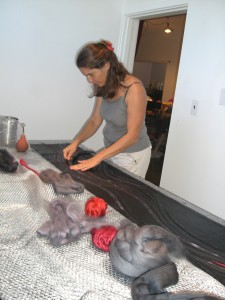In recent years as I’ve practiced the art of writing, I’ve found it significant to hear from other artists—not only writers, but musicians and visual artists as well—about the creative process. All of us are affected by our own experiences, by the places we’ve lived, by 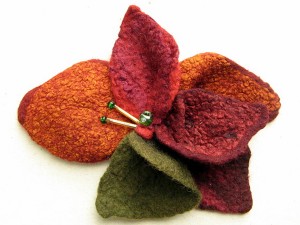
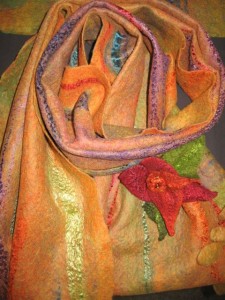 people we’ve known, and by the traditions of our own homeland. But an artist draws on these influences imaginatively and creates something new. I recently talked with a talented fiber artist who does that. Flóra Carlile-Kovács, who is Hungarian, works with the old craft of felting. Her artwork is a new take on an old beauty.
people we’ve known, and by the traditions of our own homeland. But an artist draws on these influences imaginatively and creates something new. I recently talked with a talented fiber artist who does that. Flóra Carlile-Kovács, who is Hungarian, works with the old craft of felting. Her artwork is a new take on an old beauty.
I met Flóra a few months ago through the Hungarian American Association of Washington. Not much more than a year ago Flóra moved to Seattle from Hungary with her husband Christopher, who is American, and their daughter Virág and son Vince. She moved her artistic practice here as well. It was a brave step. To be a practicing artist in a place where you know gallery owners and art vendors is challenging enough; to do it in a place where you don’t can be overwhelming. But Flóra has persevered in the work she loves, and she is finding a niche here.
Flóra describes her creations as wearable art. Using an amazing integration of color and texture, she creates hats, scarves, dresses, blouses, vests, handbags, slippers, coin purses, and ornaments such as flowers for the hair. The felting process begins with unspun wool fibers. Usually Flóra dyes the wool herself in pots outside her studio. Using an ancient textile process combining wool fibers, water, soap and vigorous kneading, she creates a durable, unwoven material called felt. In her West Seattle studio I watched her make a scarf by massaging wet, soapy woolen strands into silk fabric. The woolen lines will stay there, bound to the silk through the
felting process. Flóra showed me some dresses, blouses and vests that she had made, all without seams; the joints are made by felting. Hats are made by shaping the felt over a form. Flóra adds ornamentation not by sewing or pinning, but by working other colors and other pieces into the fabric and by manipulating and stretching it. The process reminds me of sculpting clay.
Flóra learned felting in Hungary, first through classes and then by experimenting on her own. A gallery noticed the quality of her work and began selling it, and her success spread. She participated in exhibitions in Hungary, Germany, Italy and the Czech Republic and was featured in a Hungarian magazine. She also appeared on Hungarian TV when one of her dresses won an award in a huge competition at Buda Castle. (See video.)
Her work is part of a tradition that in Hungary is called applied arts: the individual production of beautiful, useful objects. There were several artisans in Flóra’s family, and she has a deep appreciation for the craftsmanship and patience involved in the applied arts. The rhythm of her work involves dyeing, design, layout, rolling, kneading, finishing/shaping, and ironing. She has to think long-term for a project, and she enjoys every stage.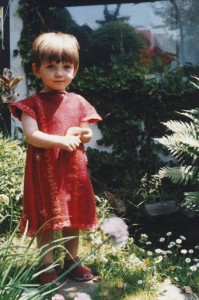
The applied arts emphasis on usefulness is part of what inspires Flóra’s designs. For example, some of her hats have a spiral pattern stretched into the fabric. The idea for this came from her own need to put up her thick hair: the spiral suggests the swirl of a hair bun, and the stretched addition provides a little more room for tucking upswept hair. But in addition to ideas coming from the use of the object, very often the inspiration for a design comes from the lines, shades, patterns and textures of the material itself. 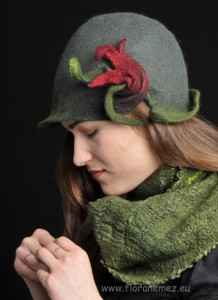
Flóra’s transition to the Northwest, starting anew in a completely different corner of the world, has certainly had its challenges. But she has been encouraged by people’s interest in her work, and her clientele is growing. She has been selling her work at art fairs and festivals and will also be participating in Christmas shows. Her studio is part of the West Seattle Art Walk on the second Thursday of every month, 6-9 p.m. She has also begun teaching felting workshops titled Felted Art in Everyday Use in her studio and has been asked to teach in Portland and on Whidbey Island.
It’s inspiring to see how she has brought her art across the globe. She has carried on with it even when the pathway hasn’t been very clear, and she’s done it beautifully. That’s dedication. That’s art.
To see Flóra Carlile-Kovács’s work or make purchases, please visit her website: http://www.Floranemez.eu/ or Facebook page: http://www.facebook.com/Floranemez
